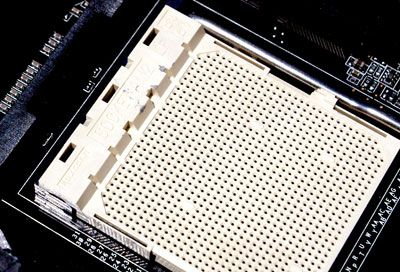AMD Socket-AM2: Same Performance, Faster Memory, Lower Power
by Anand Lal Shimpi on May 23, 2006 12:14 PM EST- Posted in
- CPUs
It's taken AMD almost the entire life-span of the Athlon 64, but Intel is finally on the run. Pick whatever measure of success you'd like, whether it is performance benchmarks, the Dell announcement, or being publicly accepted as a threat - AMD has done it. It's because of AMD's extremely successful uphill battle against Intel these past few years that we've had such high expectations from the company. So when Intel first started talking about its new Core architecture, we turned to AMD for a response that it surely must have had in the works for years, but as you all know we came up empty handed.
Only recently has AMD begun talking about what's coming next, and it will divulge even more information in the following weeks. The problem is that the architectural revisions to K8 that AMD is finally talking about now are still things we will see in the 2007 - 2008 time frame, while Intel's Core architecture is still on schedule to be a reality for 2006. What AMD does have planned to keep itself afloat during 2006 and until the new K8L core debuts is a brand new platform: Socket-AM2.
The long awaited Socket-AM2 platform marks the beginning of AMD's transition to DDR2 memory. If you'll remember, Intel made this transition about two years ago with the introduction of its 925X and 915 series of chipsets. The move to DDR2 proved to yield very little in the way of performance, but it was necessary as Intel was able to drive enough quantity of DDR2 in order to make the cost reasonable today. With DDR2 prices low enough, and availability high enough, AMD was poised to take advantage of Intel's work in establishing DDR2 as a desktop memory standard and support it on a new platform.

In AMD's uncharacteristic silence over the past several months, performance expectations for DDR2 on Socket-AM2 remained completely unset. A little over a month ago we previewed the Socket-AM2 platform and concluded that even when paired with DDR2-800, you shouldn't expect a performance increase from AM2. While AMD didn't publicly confirm or refute our benchmarks, all of its partners were in agreement with the results we had seen. Today, with final AM2 hardware in our hands, we're able to see exactly how far the platform has come in the month since we last looked at it.










83 Comments
View All Comments
darkdemyze - Tuesday, May 23, 2006 - link
z-ram isn't due for AMD procs for quite some time, I doubt this is their plan for June..mlittl3 - Tuesday, May 23, 2006 - link
Basically this is what I said above for my guess of the "trick" AMD will use. Anand said it will only affect some high-end users, read FX series so it can't be price cuts as some have suggested (that would effect everyone). Adding L3 cache is the only performance improvement I can think of that doesn't require changing the microarchitecture of the cores (well at least not a big change).However, TDP is still an issue here as someone above suggested. I don't know how much more power it takes to run L3 cache. Last time AMD did it was on K6 and power wasn't really measured back then.
By the way, please ignore Questar's comment below about z-ram being pig slow. I really don't think he knows what he is talking about. /shields eyes from incoming Questar flame
johnsonx - Wednesday, May 24, 2006 - link
K6-III did not have L3 cache. It had L2 cache, making the cache that all socket-7 boards had then an L3 cache.So, let's stop saying things like 'AMD hasn't done L3 cache since K6-III', etc.
mino - Wednesday, May 24, 2006 - link
Well, IMHO the point is AMD has used exclusive 3-level cache structure in the past so they have som experience with thi arrangement.Questar - Tuesday, May 23, 2006 - link
No flame here, look it up for yourself.Z-RAM has high capacitive loading, which results in slow speed.
At 4MB it'll run half the speed of SRAM.
Questar - Tuesday, May 23, 2006 - link
Large amounts of Z-RAM are pig slow.Ecmaster76 - Tuesday, May 23, 2006 - link
Seriously, the one area an Athlon X2 would be bandwidth starved and does it get tested in the preview? NOIn the review? NO
How long ago did we know that the K8 was not bandwidth limited in single application usage? YEARS
So yeah, DDR2 din't increase the 3dMark, big surprise
mlittl3 - Tuesday, May 23, 2006 - link
I think 3dMark06 is multithreaded now so all available cores and bandwidth should be used within the limits of the program. I could be wrong about this however.Ecmaster76 - Tuesday, May 23, 2006 - link
3Dmark06 is almost completely GPU limited. The 3Dmark CPU score did increase a bit, but I really was referring to graphics benchmarks in general.cscpianoman - Tuesday, May 23, 2006 - link
I was just noticing the performance differences between the FX and the EE. In some cases the FX tromps the EE by "gasp" 30%! In other cases the EE makes it's mark. This is part of the reason I am skeptic on Conroe. Yeah it's good. But I always take what Intel, or AMD for that matter, with a grain of salt. Just today we saw the 30% advantage translate down to about 15%. This seems just like any other generation change where 15% is to be expected. The current hype for the Conroe is a product of Intel's excellent marketing dept.